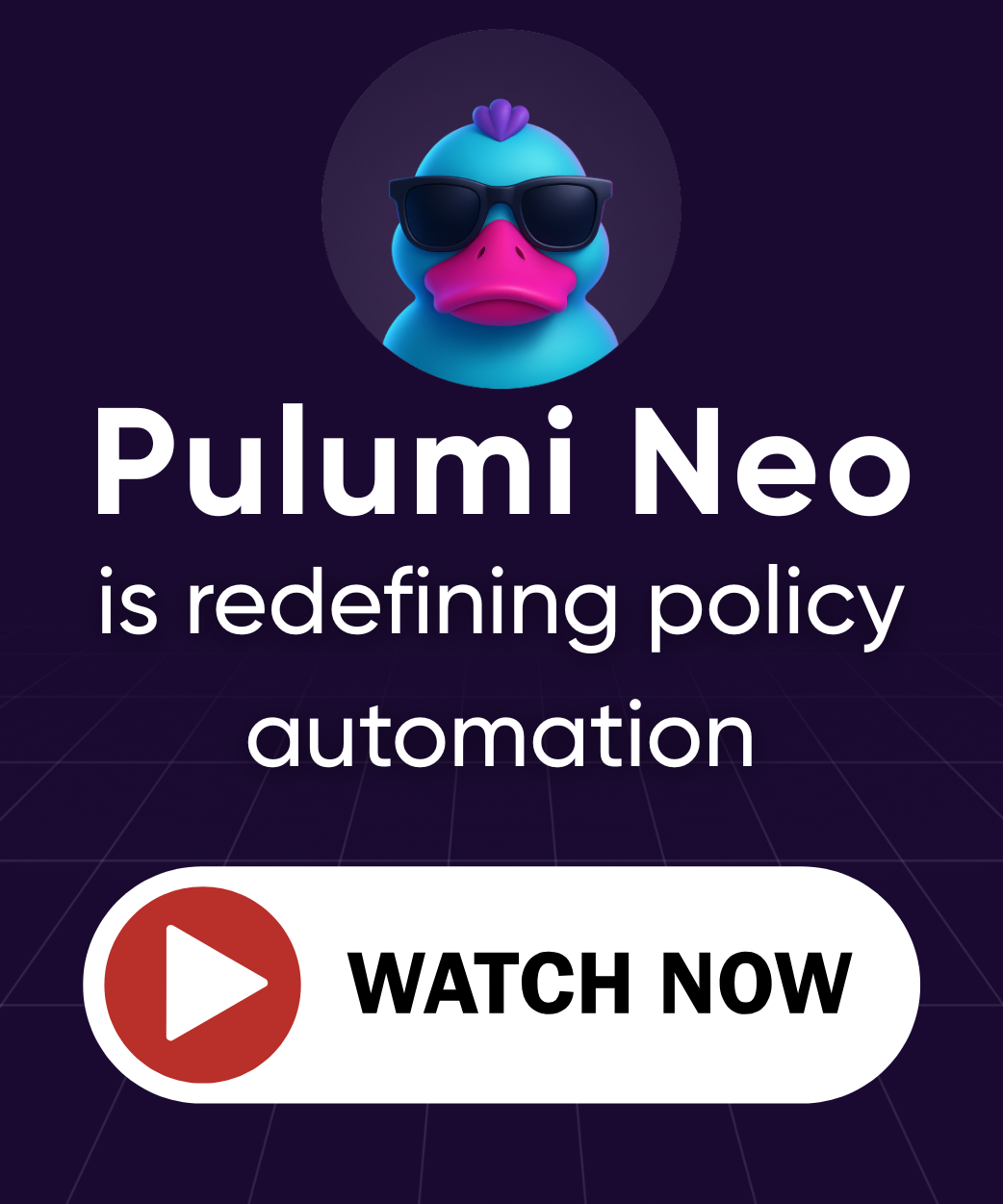Pulumi CI/CD with Buildkite
Buildkite is a continuous intergration and delivery platform designed to scale with your projects. This guide shows you how to install, configure, and run Pulumi in a Buildkite pipeline.
Prerequisites
- Sign up for a Pulumi account
- Create a Pulumi Access Token
- Save this token as a pipeline secret
named
PULUMI_ACCESS_TOKEN.
- Save this token as a pipeline secret
named
- Install the latest Pulumi CLI, so you can run the project locally as a test
- Create a new GitHub repository
- Create a new Pulumi project and initialize it as a git repository
- Obtain credentials for the cloud provider your Pulumi project will use and store them as pipeline secrets similar to the Pulumi access token from the previous step.
- Some cloud providers support OIDC token exchange. See OIDC in Buildkite Pipelines.
- A Buildkite cluster and agent. Follow the Getting Started guide to complete setup.
Install and Configure Pulumi
Pipeline steps can be defined in Buildkite directly or stored in a YAML file in your source repo. Defining steps in a YAML file will give you access to more configuration options than the web interface.
- In your source repository, create the
.buildkitefolder in the root. The Buildkite agent will look for a pipeline configuration file in a few places. You may also choose one of the other locations to store your config. - Create a new file called
pipeline.ymland paste the following pipeline configuration into the file.
Note: The pipeline assumes you are using the Node.js Pulumi SDK for your cloud infrastructure but you can, of course, use any of the languages supported by Pulumi.
env:
PULUMI_STACK: dev
steps:
- label: ":pulumi: Preview"
commands:
- npm install
- pulumi preview -s $PULUMI_STACK | tee preview
- printf '```\n%b\n```\n' "$(cat preview)" | buildkite-agent annotate --style "info"
plugins:
- secrets:
variables:
# Map the PULUMI_ACCESS_TOKEN secret to an env var of the same name.
# If you are using OIDC, this won't be needed.
PULUMI_ACCESS_TOKEN: PULUMI_ACCESS_TOKEN
#
# NOTE: Don't forget to map cloud provider credentials as env vars
# also unless you are using OIDC with the cloud provider too.
# AWS_ACCESS_KEY_ID: AWS_ACCESS_KEY_ID
# AWS_SECRET_ACCESS_KEY: AWS_SECRET_ACCESS_KEY
- pulumi#v1.0.0:
# Optional: The specific version to install
# if you don't want to use the latest
# available version.
#
# version: 3.183.0
#
# Optional: Use self-managed backend URL instead of (default) Pulumi Cloud.
# backend-url: s3://bucket_name/project_name/stack_name
#
# Optional: Use OIDC auth with Pulumi Cloud.
# use-oidc: true
# audience: urn:pulumi:org:{INDIVIDUAL_OR_ORG_LOGIN_NAME}
# pulumi-token-type: urn:pulumi:token-type:access_token:personal
# pulumi-token-scope: "user:{USER_LOGIN}"
Use of the pulumi plugin is optional.
However, if you are using OIDC auth with Pulumi, you might consider using the plugin since it handles the OIDC token exchange
with Pulumi Cloud.
Another option to consider is to use one of Pulumi’s official container images for the language you’re using. Pulumi container images have the Pulumi CLI pre-installed along with the language runtime needed to run your programs. The following example shows how you can use one of those images (or even a custom one.)
env:
PULUMI_STACK: dev
steps:
- label: ":pulumi: Preview"
commands:
- npm install
- pulumi preview -s $PULUMI_STACK | tee preview
- printf '```\n%b\n```\n' "$(cat preview)" | buildkite-agent annotate --style "info"
plugins:
- secrets:
variables:
# Map the PULUMI_ACCESS_TOKEN secret to an env var of the same name.
# If you are using OIDC, this won't be needed.
PULUMI_ACCESS_TOKEN: PULUMI_ACCESS_TOKEN
#
# NOTE: Don't forget to map cloud provider credentials as env vars
# also unless you are using OIDC with the cloud provider too.
# AWS_ACCESS_KEY_ID: AWS_ACCESS_KEY_ID
# AWS_SECRET_ACCESS_KEY: AWS_SECRET_ACCESS_KEY
- docker#v5.9.0:
image: "pulumi/pulumi-nodejs"
mount-buildkite-agent: true
environment:
- PULUMI_ACCESS_TOKEN
#
# NOTE: Don't forget to map cloud provider credentials as env vars
# also unless you are using OIDC with the cloud provider too.
# - AWS_ACCESS_KEY_ID
# - AWS_SECRET_ACCESS_KEY
Create a pull request trigger by editing the GitHub settings in the pipeline. See Buildkite docs on source control for other VCS.
Similarly, create a pipeline config YAML that runs pulumi up when a commit is pushed to your default branch.
env:
PULUMI_STACK: xxx
steps:
- label: ":pulumi: Up"
commands:
- npm install
- pulumi up -s $PULUMI_STACK
plugins:
# Use pulumi plugin or the Docker plugin to ensure Pulumi is installed.
...
Next Steps
This guide covered a simple way of running Pulumi in a Buildkite pipeline.
As your Pulumi project grows and you add more stacks to a project, you
can make the stack name dynamic (the PULUMI_STACK env var in the examples
above) and run a pipeline for a specific stack based on a branch.
Dynamic Pipelines
Buildkite allows you to create dynamic pipelines. Similar to Pulumi, Buildkite, too, allows you to use a programming language to generate pipeline configurations dynamically at build time.
Cache Volumes
Cache volumes are
external volumes attached to hosted agent instances. They can be used to cache Pulumi
plugins that get installed in $HOME/.pulumi/plugins, as well as any language-specific
packages, i.e. node_modules etc. Pulumi plugin binary versions are 1:1 with the
versions of the Pulumi packages that use them.
Thank you for your feedback!
If you have a question about how to use Pulumi, reach out in Community Slack.
Open an issue on GitHub to report a problem or suggest an improvement.
